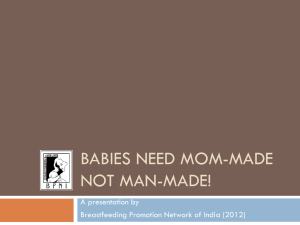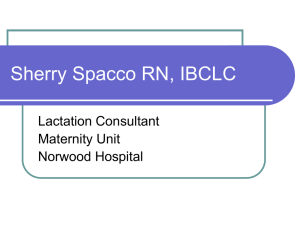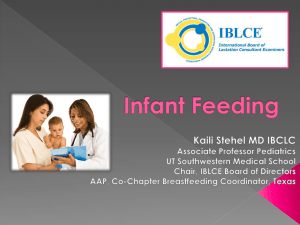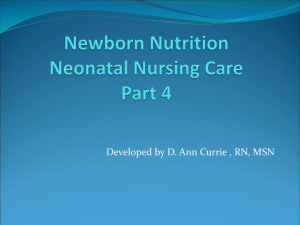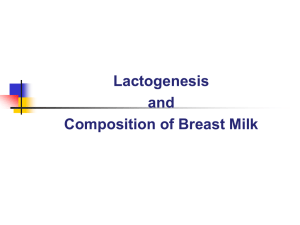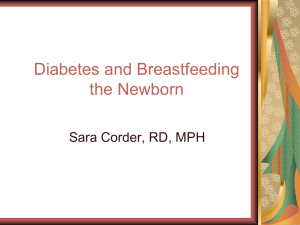Maternal chapter7
advertisement
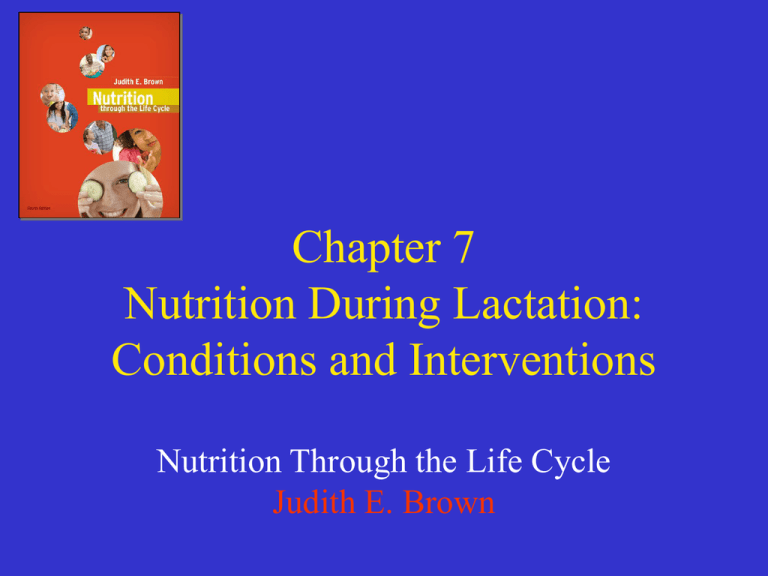
Chapter 7 Nutrition During Lactation: Conditions and Interventions Nutrition Through the Life Cycle Judith E. Brown Introduction • Two key considerations related to conditions and interventions during breastfeeding are: 1) The vast majority of women do not experience significant problems during breastfeeding 2) Most problems could have been prevented with proper prenatal breastfeeding education & a positive breastfeeding initiation period Common Breastfeeding Conditions • • • • • • • • Sore, flat or inverted nipples Letdown failure Hyperactive letdown Hyperlactation Engorgement Plugged duct Mastitis (Infection) Low milk supply Condition: Sore nipples • May be prevented by proper positioning of baby on breast • The areola should be in the baby’s mouth with tongue extended against lower lip Condition: Flat or Inverted Nipples • This should not impact breastfeeding if the latch is correct. • If difficult to latch: – Mother may roll her nipple between her fingers – Or use a breast pump prior to feeding • Helps to draw out the nipple Condition: Letdown Failure • • • • When milk does not eject from the breast Very uncommon Oxytocin nasal spray may be prescribed Relaxation techniques may help reduce problem Condition: Hyperactive Letdown • Streams of milk come from breast • If too active, may cause infant to choke while nursing • Management: – Wait for the milk flow to slow down before putting the infant to the breast – Mother may express milk until the flow slows then allow infant to nurse Condition: Hyperlactation • Occurs when milk volume produced exceeds intake of the baby – Symptoms in mother: • • • • Breasts not drained completely Chronic plugged ducts Leaking between feedings Pain with letdown or deep in breast – Symptoms in baby: • Spitting up, poor weight gain • Difficulty maintaining latch Condition: Hyperlactation • Occurs when milk volume produced exceeds intake of the baby • Management: – Reduce production • Nurse baby on one side only and express for comfort on the other • Cabbage leaves may be used to decrease production Condition: Engorgement • Breasts are overfilled with milk • Results when supply-and-demand process is not yet established and milk is abundant • Best prevention: nurse frequently— newborns may nurse every 1 to 2 hours Condition: Plugged Duct • • • • Caused by milk staying in the ducts Painful knot may form in breast Treated by massage and warm compress Prevented by complete emptying of breasts and changing position of infant while feeding Condition: Mastitis (Infection) • Mastitis is inflammation of the breast – May be infective or non-infective • Occurs in 3 to 20% of breastfeeding women • Most common at 2-6 weeks postpartum • May result from: – Sore and cracked nipples – Blood borne source of bacterial infection – Missing a feeding resulting in engorgement, then plugged duct may precipitate engorgement Condition: Low Milk Supply • Most common reason for cessation of breastfeeding – May be real or may be perceived • Causes: – Insufficient breastfeeding or pumping – Ineffective emptying – Stress • Management – Nurse or pump every 2-3 hours – Drugs or herbs may be prescribed • Galactogogue, Metoclopromide, Fenugreek Maternal Medications • Most medications are excreted in breast milk • Variables to consider related to medications during lactation: – Pharmacokinetic properties of the drug – Time-averaged breast milk/plasma drug concentration ratio – Drug exposure index – Infant’s ability to absorb, detoxify & excrete drug – Infant’s age, feeding pattern, total diet, & health Resources on Drugs, Medications. and contaminants in human milk Maternal Medications • Drugs are divided into 7 categories – Cytotoxic drugs- interferes with infant's cellular metabolism – Drugs of abuse-adverse effects – Radioactive compounds-temporary cessation of breastfeeding – Drugs in which effect is unknown – Drugs associated with significant effect – Meds compatible with breastfeeding – Agents with no effect on breastfeeding Safety of Oral Contraceptive Use During Lactation • Current evidence suggests combined oral contraceptives (OC) may reduce the volume of breast milk • The ACOG & WHO recommend against use of combined OC during first 6 weeks postpartum • Progestin only OC & implants are safe & effective Herbal Remedies • Scientific information about herb use during lactation is sparse • Medicinal herbs should be viewed as drugs • Many herbs are contraindicated during lactation Herbal Remedies • Table 7.4 lists “Herbs traditionally used to affect milk production” • Table 7.5 lists “Medicinal herbs considered not appropriate for use during pregnancy or lactation” • Table 7.6 lists “Herbal teas considered safe during lactation” Herbs Widely Used in the U.S. with Impact on Breastfeeding – – – – – – Echinacea - not recommended Ginseng root - not recommended St. John’s wort - may reduce milk supply Ephedra (ma huang) - not recommended Fenugreek - infants may be allergic Cabbage leaves - safe for topical use to reduce engorgement – Goat’s Rue and Milk Thistle/Blessed Thistlepotential use as galactogues Alcohol and Other Drugs • • • • • • Alcohol Nicotine (smoking cigarettes) Marijuana Caffeine Other drugs of abuse Environmental exposures Alcohol • Alcohol consumed quickly passes to breast milk • Level of alcohol in breast milk is same as in maternal plasma • Peak plasma levels occur at 30-60 min. after consumption if consumed w/o food and 60-90 min. if consumed with food • Contrary to popular belief, alcohol decreases oxytocin and let-down Impact of Alcohol on Lactation • Contrary to popular belief, alcohol decreases oxytocin & let-down • Affects odor of milk • Decreases volume consumed by infant • Interferes with sleep pattern of infant Alcohol and Breastfeeding Other Drugs and Lactation • Nicotine (smoking cigarettes) – Regardless of feeding choice, the health risks for infants posed by a smoking mother are many • • • • Otitis media Exacerbation of asthma Respiratory infections Gastrointestinal dysregulation – Levels are 1.5 to 3 times higher in breast milk than mother’s blood Other Drugs and Lactation • Marijuana – Is transferred and concentrates in breast milk and it metabolized by the nursing infant – May change DNA/RNA & the proteins needed for growth Other Drugs and Lactation • Caffeine – Moderate intake causes no problems for most breastfeeding infants and mothers. – Level in breast milk is only 1% of that in mother’s plasma – May accumulate in infants younger than 3 to 4 months—varies from infant to infant – May interfere with sleep or cause hyperactivity & fussiness of infant Other Drugs and Lactation • Other drugs of abuse • Amphetamines, cocaine, heroin, & phencyclidine (angel dust, PCP) are classified by the AAP as drugs of abuse that are contraindicated during lactation Environmental Exposures “The advantages of breastfeeding far outweigh the potential risks from environmental pollutants. Taking into account breastfeeding’s short- and long-term health benefits for infants and mothers, the WHO recommends breastfeeding in all but extreme circumstances.” − World Health Organization Neonatal Jaundice and Kernicterus • Jaundice—a yellow color of the skin seen in about 60% of full-term & 80% of preterm infants (AKA hyperbilirubinemia) • If not resolved, the elevated bilirubin can cause permanent neurological damage • It is the most frequent cause for hospital readmission for newborns Risk Factors for Severe Hyperbilirubinemia Bilirubin Metabolism • Bilirubin—a pigment produced as heme from red blood cells (RBC) break down •Usually processed by the liver and excreted in the baby’s stool • Newborn’s liver not fully mature so jaundice is common during first few days of life • Color appears first in the face & upper body then progresses downward toward the toes Bilirubin Metabolism • In the fetal state, high levels of hemoglobin were needed to carry oxygen delivered by the placenta • At birth, infants have very high levels of hemoglobin and hematocrits of 50% to 60% • As infant breathes on his own, high hemoglobin is not needed, so RBC begin to break down Physiologic versus Pathologic Newborn Jaundice • Physiological • Begins after the 1st day of birth rising steadily with peak ~ day 6-7 • Bilirubin <12 mg/dL • Condition resolves within a few days • Cause: normal heme breakdown • Pathological • Begins within 1st day after birth rises rapidly & lasts longer • Bilirubin >8 mg/dL in 1st day • Medical intervention with phototherapy • Cause: various pathological Bilirubin Encepahlopathy or Kernicterus • Bilirubin is toxic to cells & may cause brain damage – Brain & brain cells destroyed by bilirubin do not regenerate • Mortality rate is 50% • May cause: cerebral palsy, hearing loss, paralysis of upward gaze, and intellectual and other handicaps Breast-Milk Jaundice Syndrome • Onset later than physiological jaundice—typically 7th to 10th day – 1/3 of breast-fed infants are jaundiced at 3 weeks • Cause is unknown – Thought that more bilirubin is reabsorbed due to factors in breast milk that promote its absorption • Typically resolves itself but in severe cases is treated like regular physiological jaundice Treating Jaundice • The AAP guidelines recommend phototherapy using fluorescent lights • Light is absorbed in bilirubin changing it to a water-soluble product that can be excreted via the kidneys • AAP guidelines encourage continuation of breastfeeding Information for Parents • Inform parents that most breastfed infants will become jaundiced • Only a small fraction of these infants will develop extreme hyperbilirubinemia and kernicterus Breastfeeding Multiples • Breastfeeding twins, triplets & quadruplets is possible – Main obstacle is the time & fatigue of mother • Frequent nursing increases milk supply • Parents of multiples need support in: – – – – Organization Feeding Individualization Stress management Infant Allergies • Exclusive breastfeeding for ≥4 months protects against allergies, ectopic dermatitis & wheezing • Development of food allergies influenced by numerous factors: – Genetics, duration of breastfeeding, time of introduction of other foods, maternal smoking, air pollution, exposure to infectious disease, maternal diet and immune systems • Consumption of omega-3 fatty acids by lactating mother may protect against Allergies Food Intolerance • No scientific evidence shows gassy foods in mother’s diet produce gas in infant • Low-allergen maternal diet associated with reduction in distressed behavior (colic) – Allergenic foods eliminated were cow’s milk, eggs, peanuts, tree nuts, wheat, soy, & fish Late-Preterm Infants • Infant born 34 to 37 weeks • May have subtle immaturity making breastfeeding difficult • Complications include: – Cardio-respiratory instability, poor temperature control, lower glycogen & fat stores, immature immune system, weak suck-swallow coordination Near-Term Breastfeeding Cascade Human Milk and Preterm Infants “Hospital and physicians should recommend human milk for premature and other high-risk infants either by direct breastfeeding and/or using the mother’s own expressed milk. Maternal support and education on breastfeeding and milk expression should be provided from the earliest possible time. Mother-infant skin-to-skin contact and direct breastfeeding should be encouraged as early as feasible. Fortification of expressed human milk is indicated for many very low birth weight infants.” − AAP Statement Medical Contraindications to Breastfeeding • Few medical problems in the mother or baby are absolute contraindications to breastfeeding • Table 7.14 lists the medical problems and contraindications for breastfeeding • The theoretical risk must be measured against the projected benefits of breastfeeding Breastfeeding and HIV Infection • HIV infection may be transmitted to infant by breast milk • Transmission rates 5 to 20% depending on duration of breastfeeding • DHHS recommends: “HIV infected women should not breastfeed or provide their breast milk for the nutrition of their own or other infants...” Human Milk Collection and Storage “Human milk is the most appropriate food for infants and is also used as medical therapy for older children and adults with certain medical conditions. Human milk has a long history and proven track record both as nutrition and therapy.” – Human Milk Banking Association of North America Human Milk Collection and Storage Milk Banking • Human milk banks – Provide human milk to infants who cannot be breastfed by their mothers – Some neonates ICUs had milk banks until the 1980s when HIV infections, resurgence of TB and other risks became prevalent Model Programs • Breastfeeding Promotion in Physicians’ Office Practices (BPPOP) – Innovative program designed to boost breastfeeding promotion and support • The Rush Mothers’ Milk Club – Evidence based program of breastfeeding interventions in NICU

